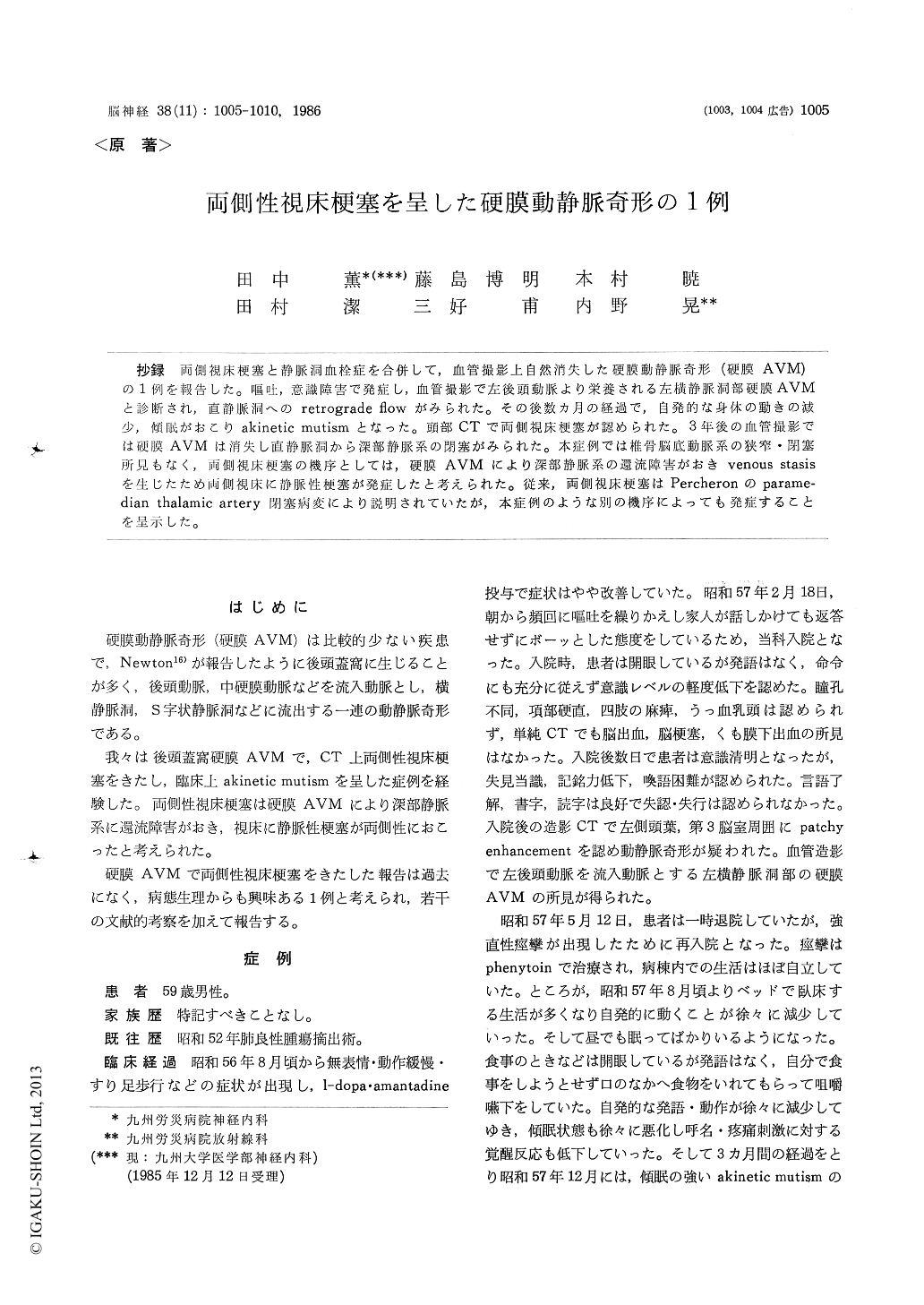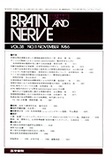Japanese
English
- 有料閲覧
- Abstract 文献概要
- 1ページ目 Look Inside
抄録 両側視床梗塞と静脈洞血栓症を合併して,血管撮影上自然消失した硬膜動静脈奇形(硬膜AVM)の1例を報告した。嘔吐,意識障害で発症し,血管撮影で左後頭動脈より栄養される左横静脈洞部硬膜AVMと診断され,直静脈洞へのretrograde flowがみられた。その後数カ月の経過で,自発的な身体の動きの減少,傾眠がおこりakinetic mutismとなった。頭部CTで両側視床梗塞が認められた。3年後の血管撮影では硬膜AVMは消失し直静脈洞から深部静脈系の閉塞がみられた。本症例では椎骨脳底動脈系の狭窄・閉塞所見もなく,両側視床梗塞の機序としては,硬膜AVMにより深部静脈系の還流障害がおきvenous stasisを生じたため両側視床に静脈性梗塞が発症したと考えられた。従来,両側視床梗塞はPercheronのparame-dian thalamic artery閉塞病変により説明されていたが,本症例のような別の機序によっても発症することを呈示した。
A 59-year-old man was admitted because of fre-quent vomiting and obtundation in February 1982. Neurological examination on admission revealed only slight impairment of consciousness. Papil-ledema, meningeal irritation sign and paralysis were not elicited. The plain CT scan was normal, but the CT scan with contrast material showed patchy enhancement in the left temporal lobe and around the third ventricle. Cerebral angiography showed a dural arteriovenous malformation (dural AVM) in the left transverse sinus fed by the left occipital artery, and the retrograde flow into the straight sinus. By the third day following admis-sion, the level of consciousness became alert. The patient did not complain of headache, bruit and visual disturbance. He showed mild disorientation and memory disturbance. But his ordinary daily-living was independent.
In August 1982, the patient gradually became inactive and apathetic. At times he lay in bed with moving his eyes, swallowing foods. At other times, he lay in bed with closing his eyes, immo-bile, and unresponsive except to strong painful stimuli. The patient was incontinent and required nursing care. During three month periods, the patient progressively became somnolent, speech-less and immobile. Eventually, he was in a state of akinetic mutism. The patient became unrespon-sive. The state of consciousness fluctuated within a narrow range. The pupils were isocoric and did not react to light. He sometimes moved his eyes horizontally, but the vertical eye movement was limited. Deep tendon reflexes were hyperactive with Babinski reflex bilaterally. Passive mobiliza-tion of extremities revealed hypertonic. The CT scan disclosed the bilateral symmetrical infarction of the thalamus.
In June 1985, repeated cerebral angiography showed disappearance of the dural AVM, occlusion of the straight sinus and deep cerebral veins. There was no stenotic or occlusive lesion in the vertebrobasilar arteriogram. Previous references state that the mechanism of bilateral thalamic in-farction is considered due to occlusion of parame-dian thalamic artery (thalamo-subthalamic palame-dian artery) which was reported by Percheron. The paramedian thalamic artery arises from the basilar communicating artery which is situated bet-ween the upper extremity of the basilar artery and the ostium of the posterior communicating artery. The artery supplys bilateral subthalamic and thala-mic territory. However, in this case, the clinical course and the infarcted area surmised from CT scan were not compatible with occlusion of para-median thalamic artery. Our study suggested that another mechanism for bilateral thalamic infarction could be considered. In this case, retrograde venous drainage to the straight sinus by AV shunt raised venous pressure and caused venous stasis. We speculated that venous infarction of the bi-lateral thalamus was due to impaired venous drain-age.

Copyright © 1986, Igaku-Shoin Ltd. All rights reserved.


